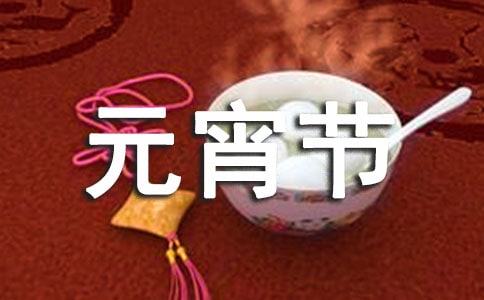- 相关推荐
元宵节的来历和意义
until the sui dynasty in the sixth century, emperor yangdi invited envoys from other countries to china to see the colorful lighted lanterns and enjoy the gala(节日的,庆祝的)performances. by the beginning of the tang dynasty in the seventh century, the lantern displays would last three days. the emperor also lifted the curfew(宵禁令), allowing the people to enjoy the festive lanterns day and night. it is not difficult to find chinese poems which describe this happy scene.

in the song dynasty, the festival was celebrated for five days
and the activities began to spread to many of the big cities in china. colorful glass and even jade were used to make lanterns, with figures from folk tales painted on the lanterns.
however, the largest lantern festival celebration took place in the early part of the 15th century. the festivities continued for ten days. emperor chengzu had the downtown area set aside as a center for displaying the lanterns. even today, there is a place in beijing
called dengshikou. in chinese, deng means lantern and shi is market. the area became a market where lanterns were sold during the day. in the evening, the local people would go there to see the beautiful lighted lanterns on display.
today, the displaying of lanterns is still a big event on the 15th day of the first lunar month throughout china. people enjoy the brightly lit night. chengdu in southwest china's sichuan province, for example, holds a lantern fair each year in the cultural park. during the lantern festival, the park is literally an ocean of
lanterns! many new designs attract countless visitors. the most eye-
catching lantern is the dragon pole. this is a lantern in the shape of a golden dragon, spiraling up a 27-meter -high pole, spewing fireworks from its mouth. it is quite an impressive sight!
元宵节的来历意义
农历正月十五元宵节,又称为“上元节”,春灯节,是中国汉族民俗传统节日。正月是农历的元月,古人称夜为“宵”,而十五日又是一年中第一个月圆之夜,所以称正月十五为元宵节。又称为小正月、元夕或灯节,是春节之后的第一个重要节日。中国幅员辽阔,历史悠久,所以关于元宵节的习俗在全国各地也不尽相同,其中吃元宵、赏花灯、舞龙、舞狮子等是元宵节几项重要民间习俗。
每年农历的正月十五日,春节刚过,迎来的就是中国汉族的传统节日之一的元宵节,正月是农历的元月,古人称夜为“宵”,所以称正月十五为元宵节。正月十五日是一年中第一个月圆之夜,也是一元复始,大地回春的夜晚,人们对此加以庆祝,也是庆贺新春的延续。元宵节又被称为“上元节”。
按中国民间的传统,在这天上皓月高悬的夜晚,人们要点起彩灯万盏,以示庆贺。
出门赏月、燃灯放焰、喜猜灯谜、共吃元宵,合家团聚、同庆佳节,其乐融融。元宵节的节期与节俗活动,是随历史的发展而延长、扩展的。就节期长短而言,汉代才一天,到唐代已为三天,宋代则长达五天,明代更是自初八点灯,一直到正月十七的夜里才落灯,整整十天。与春节相接,白昼为市,热闹非凡,夜间燃灯,蔚为壮观。特别是那精巧、多彩的灯火,更使其成为春节期间娱乐活动的高-潮。至清代,又增加了舞龙、舞狮、跑旱船、踩高跷、扭秧歌等“百戏”内容,只是节期缩短为四到五天。
元宵节的由来
汉高祖刘邦死后,吕后独揽朝政把刘氏天下变成了吕氏天下。吕后病死后,“诸吕”惶惶不安,害怕遭到伤害和排挤。于是,在上吕禄家中秘密集合,共谋作乱之事,以便彻底夺取刘氏江山。
此事传至刘氏宗室齐王刘襄耳中,刘襄为保刘氏江山,决定起兵讨伐诸吕。随后,刘襄与开过老陈周勃、陈平等,一起设计除了吕禄,“诸吕之乱”在正月十五被彻底平定。
平乱之后,众臣拥立刘邦的第二个儿子刘恒登基,称汉文帝,汉文帝深感太平盛世来之不易,为纪念平息“诸吕之乱”,每年正月十五夜,他都要出宫游玩,与民同乐。
“夜”在古语中,又叫“宵”,正月又叫元月,汉文帝就将正月十五定为元宵节。从此,正月十五便成了一个普天同庆的民间节日——“闹元宵”。
趣味链接:元宵节观灯源于何时?
元宵节这天晚上,我国许多地方有观灯的风俗。据说,这种习俗始于汉代。
汉明帝时期(公元58~75年)提倡佛法,敕令在元宵节点灯敬佛,这就开了元宵节放灯的先例。以后,京城和民间每年元宵节之夜
都有放灯的活动。
隋唐时,这个习俗为人们所重视,当时已发展成盛大的灯市。到宋元时期,京都灯市规模更为壮观,常常绵延数十里。
关于元宵节闹花灯,在民间还有一个传说。
很久以前,凶禽猛兽很多,四处伤害人和牲畜,人们就组织起来消灭他们。有一只神鸟因为迷路而降落人间,却意外的被猎人射杀了。
玉帝知道后十分震怒,命令天兵于正月十五日到人间放火,烧尽人间的一切。玉帝的女儿心地善良,不忍心看百姓无辜受难,悄悄地把这个消息告诉了人们。
众人听说后,吓得不知如何是好。此时,有一位长者建议在正月十四、十五、十六日这三天,家家都张灯结彩、点响爆竹,以迷惑天帝。
到了正月十五这天晚上,玉帝往下一看,发现人间一片红光,响声震天,连续三个夜晚都是如此,以为是大火在燃烧,心中大快。
人们就这样保住了自己的生命及财产。从此,每到正月十五,家家户户都悬挂灯笼,放烟火来纪念这个日子。
【元宵节的来历和意义】相关文章:
正月十五元宵节的来历和习俗03-08
正月十五元宵节的来历和习俗2篇03-09
元宵节的来历教案02-02
军训的目的和意义05-31
戒指的戴法和意义03-08
正月十五元宵节的来历04-27
元宵节观灯会来历03-23
小班语言元宵节的来历教案02-04
元宵节的来历教案3篇03-10
二月二的来历和习俗02-27